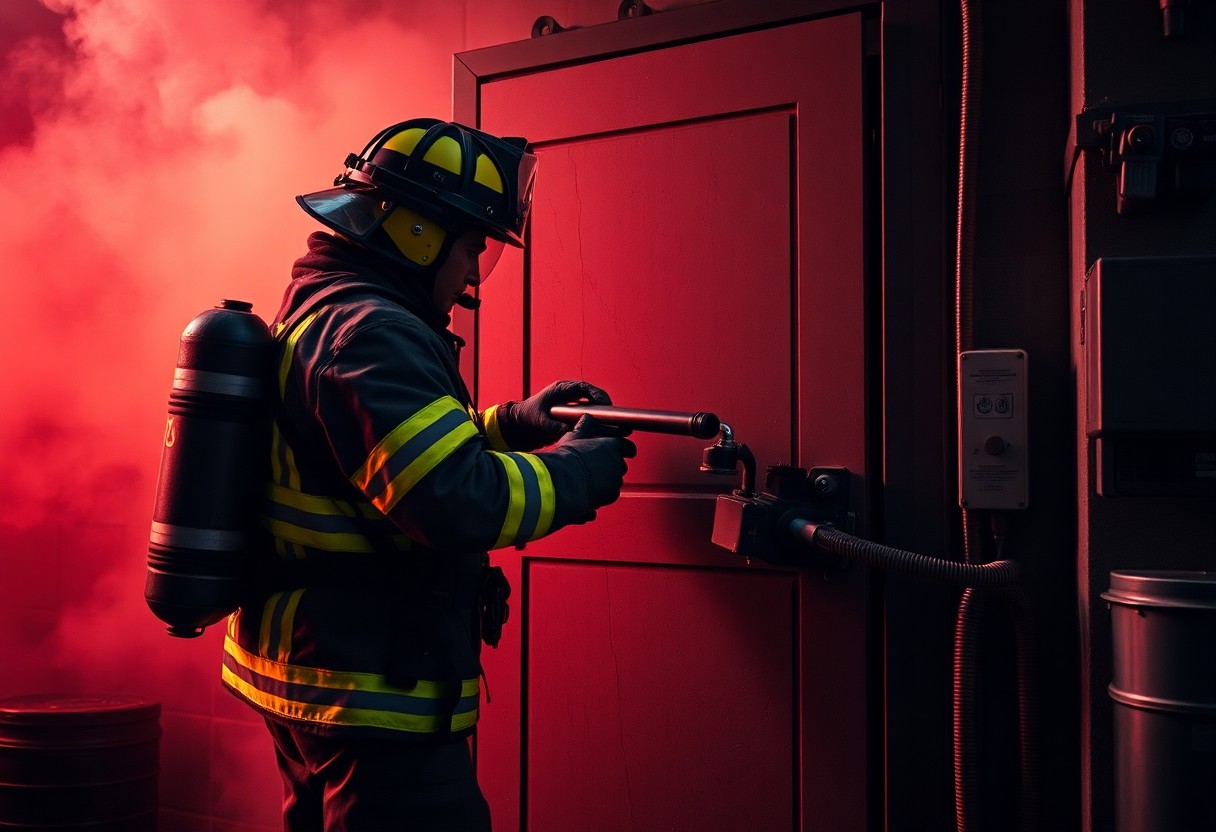Over time, mastering forcible entry skills is vital for any firefighter or emergency responder aiming to improve their effectiveness in emergency situations. This skill set not only enhances your ability to gain access to structures but also ensures the safety of those trapped inside. In this post, you will explore important techniques that will elevate your proficiency, from the fundamental tools to specific methods suited for various door types. Understanding these tactics will empower you to act decisively and efficiently when every second counts.
Understanding Forcible Entry
Your mastery of forcible entry begins with a clear understanding of its purpose and techniques. Forcible entry involves gaining access to a structure when normal means of entry are obstructed, often during emergency situations. Whether it’s rescuing a trapped individual or extinguishing a fire, knowing the ins and outs of forcible entry can make a significant difference in life-threatening scenarios.
Importance of Forcible Entry Skills
Across various emergency situations, effective forcible entry skills play a vital role in ensuring the safety of victims and first responders alike. Being adept at these techniques helps you overcome barriers swiftly, allowing for timely interventions that can save lives, protect property, and enhance overall operational efficiency in crisis circumstances.
Common Challenges Faced
Among the various challenges you may encounter, the physical nature of forcible entry, resistance of different door types, and the urgency of situations can pose significant hurdles. Each entry point requires specific techniques and tools, and lack of experience can lead to costly delays.
Even seasoned professionals face common challenges when it comes to forcible entry. Factors such as the design and materials of doors, the need for teamwork, and ensuring safety while conducting operations add layers of complexity. Understanding these challenges helps you prepare better, enabling you to adapt to the unpredictable nature of emergency situations and enhance your effectiveness in the field.
Tools and Equipment
Assuming you want to excel in forcible entry skills, understanding your tools and equipment is fundamental. Each tool has its unique purpose and functionality, tailored to various scenarios you may encounter. Familiarizing yourself with the right gear will not only enhance your efficiency but also ensure you can respond effectively under pressure.
Essential Tools for Forcible Entry
By selecting the proper tools for forcible entry, you equip yourself for success. The vital tools include a pry bar, battering ram, rotary saw, and locking mechanism tools. Each tool is designed for specific entry methods, allowing you to adapt your approach based on the situation you face.
Maintenance and Care of Tools
Against all odds, well-maintained tools can significantly improve your performance during forcible entry operations. Regular inspections, cleaning, and proper storage are vital to ensuring longevity and reliability in high-pressure situations.
Another key aspect of maintaining your tools involves understanding their operational mechanisms. Regularly inspecting for wear and tear, lubricating moving parts, and replacing damaged components are vital steps. Keeping your tools in peak condition not only extends their lifespan but ensures their reliability, making you more effective when it truly counts.
Techniques for Forcing Entry
Any successful forcible entry requires mastering various techniques that cater to different situations and door types. You should familiarize yourself with methods such as kicking, using tools like a Halligan, and understanding leverage principles. Each technique has its own advantages and nuances that can make all the difference when time is of the essence and lives are at stake.
Kicking Techniques
Entry using kicking techniques can be effective for doors that are not heavily reinforced. You will want to target the door just above the lock, aiming to deliver a powerful, well-placed kick to break the latch or strike the lock mechanism. Proper timing and positioning are key to maximizing impact while minimizing injury risk.
Using a Halligan Tool
Behind many effective forcible entry methods lies the Halligan tool, a versatile implement that combines a wedge, pick, and adz. With its unique shape, you can effectively pry open doors, windows, and hatches, providing quick access in emergency situations. Familiarizing yourself with the Halligan’s use will enhance your efficiency during critical scenarios.
A Halligan tool is invaluable for any firefighter or rescue professional, offering multiple functions in one compact design. Its heavy-duty construction and ergonomic shape allow for effective leverage, enabling you to pry apart door components or create a gap for further entry. Practicing its use not only builds your confidence, but also ensures that you can respond effectively under pressure, making it an vital part of your forcible entry skills.
Situational Awareness
Many successful forcible entry operations rely heavily on situational awareness. By understanding your surroundings, evaluating the conditions, and recognizing potential hazards, you can make quick, informed decisions during a high-stress situation. This heightened awareness allows you to effectively coordinate with your team and respond appropriately to unexpected developments, ultimately enhancing your ability to gain entry safely and efficiently.
Assessing the Environment
Any situation requires thorough assessment of the environment before proceeding. This means gaining knowledge about the layout of the building, identifying escape routes, and recognizing any dangers that may impede your progress, such as obstacles or hazardous materials. By determining the best approach, you empower yourself for a safer and more efficient entry.
Recognizing Lock Types
Lock types are necessary indicators of how you will approach entry. Understanding different locks helps you choose the correct forcible entry technique. Familiarize yourself with common types of locks you may encounter:
- Pin tumbler locks
- Deadbolts
- Sliding locks
- Padlocks
- Smart locks
Knowing how each of these locks operates can significantly impact your strategy.
| Lock Type | Characteristics |
| Pin Tumbler Lock | Common in residential doors; uses pins that must align to unlock. |
| Deadbolt | Offers higher security; requires a key or thumb turn to operate. |
| Sliding Lock | Typically found on sliding glass doors; can be tricky if obstructed. |
| Padlock | Portable lock that can be used on various applications; often found on gates. |
| Smart Lock | Operated electronically; may require specialized tools for forcible entry. |
Understanding the mechanics of locks allows you to adapt your entry techniques accordingly and enhances the chances of a successful operation. Your knowledge about their construction can improve your efficiency and effectiveness in overcoming any barrier:
- Visual identification techniques
- Using tools best suited for each type
- Assessing weaknesses in the lock
- Determining which method is least destructive
- Adapting to unexpected lock types quickly
Knowing these factors will empower you to act decisively and effectively in the field.
| Lock Type | Common Location |
| Pin Tumbler Lock | Residential Doors |
| Deadbolt | Main Entrances |
| Sliding Lock | Patio Doors |
| Padlock | Gates, Sheds |
| Smart Lock | High-Tech Homes |
Safety Measures
Now, when it comes to forcible entry, safety measures are paramount to ensuring the well-being of you and your team. Proper planning, risk assessment, and awareness of your surroundings can mitigate hazards that may arise during operations. Adhering to established safety protocols not only safeguards everyone involved but also enhances your effectiveness during the critical moments of a forcible entry. Always prioritize safety to maintain a professional approach to your tasks.
Personal Protective Equipment (PPE)
An necessary element of safety is utilizing appropriate Personal Protective Equipment (PPE). Ensure you wear helmets, gloves, eye protection, and fire-resistant gear to guard against potential injuries during entry operations. The right PPE equips you to handle various situations confidently and protects you from unpredictable elements in emergency environments.
Team Coordination and Communication
An effective strategy for successful forcible entry involves diligent team coordination and communication. Clear dialogue amongst team members fosters a collective understanding of the objectives and methodologies, ensuring every member is informed and engaged in the operation.
And, by maintaining open lines of communication, you can quickly relay critical information, provide updates, and address any changes that may arise during the process. Utilizing hand signals or designated calls can help streamline operations, particularly in high-stress scenarios, enabling you and your team to act decisively and in unison. This coordination not only enhances safety but also increases efficiency, leading to a more successful forcible entry.
Practical Drills and Training
Unlike many other fire service skills, mastering forcible entry requires repetitive practice through structured drills. Engaging in regular training exercises helps you refine your techniques, build muscle memory, and improve your speed and efficiency in high-pressure situations. Incorporating a variety of tools and scenarios into your drills ensures that you are well-prepared for the differing challenges that forcible entry presents during emergencies.
Simulation Exercises
The effectiveness of simulation exercises cannot be overstated. These drills create a controlled environment that mimics real-life scenarios, allowing you to practice your skills with different entry tools and techniques. By participating in these exercises, you can develop problem-solving abilities and enhance teamwork among your crew, all while minimizing risks associated with live emergencies.
Real-World Scenarios
Training in real-world scenarios is important for applying your forcible entry skills effectively. These practical experiences allow you to navigate actual conditions and unpredictable variables that could arise during emergencies.
And as you engage in real-world scenarios, you heighten your ability to adapt your techniques on the fly. Challenges such as varying door types, environmental factors, and time constraints require your problem-solving skills to be actionable. These encounters not only boost your confidence but also underline the importance of collaboration and communication with your team, ensuring everyone is prepared when it matters most.
To wrap up
Now that you understand the key techniques for mastering forcible entry skills, focus on practicing tools like the prying tool, sledgehammer, and K-tool to build your proficiency. It’s crucial to develop your situational awareness and teamwork abilities, as they can significantly impact your effectiveness during real-life scenarios. Regular training and drills will enhance your muscle memory and decision-making skills. By consistently applying these techniques, you will become a more competent and confident first responder, ready to tackle any forcible entry challenge that comes your way.



